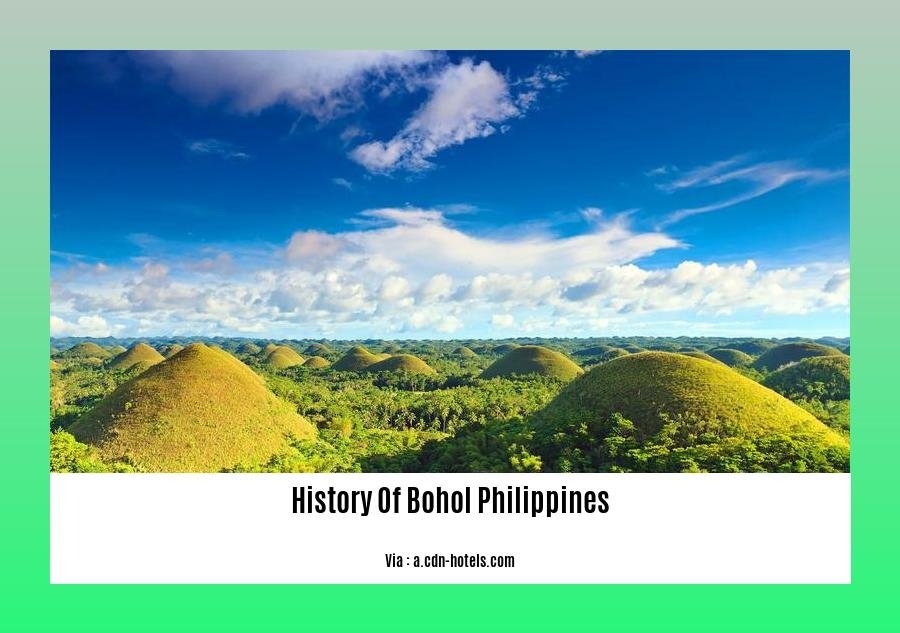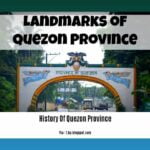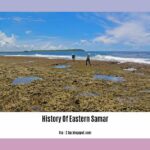Journey through the captivating tapestry of Bohol’s past as we unravel the rich history of this enchanting island in the Philippines. From ancient settlements and cultural influences to the arrival of Spanish conquistadors and the struggle for independence, Bohol’s story is a vibrant blend of diverse traditions, heroic struggles, and remarkable achievements. Let’s embark on a historical voyage to discover the essence of this remarkable place, where every chapter holds valuable lessons and unfolds the fascinating narrative of Bohol’s identity.
Key Takeaways:
- Bohol is an island province in the Philippines comprising the main island and 75 smaller surrounding islands.
- Its capital city is Tagbilaran.
- The province’s name originates from “Bo-ho” or “Bo-ol,” referring to the final group of inhabitants who settled in the Philippines, known as the Pintados, who were distinguished by their tattoos.
- The Pintados were living embodiments of their folk art and culture, adorning their bodies with indigenous paint extracted from local plants.
- Bohol was initially part of Cebu’s residencia during the Spanish colonial period but became a separate politico-military province on July 22, 1854.
- Bohol is renowned for attractions such as the Chocolate Hills, the Tarsier Conservation Sanctuary, and the National Museum of the Philippines – Bohol, housed in the former Provincial Capitol building constructed between 1855 and 1860.
History of Bohol, Philippines
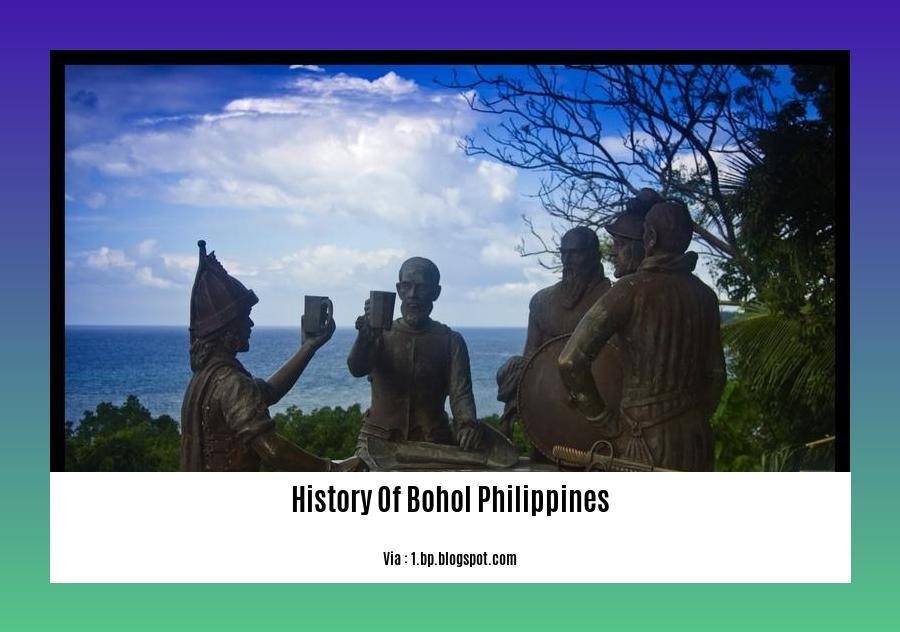
Embark on a journey to unravel the tapestry of Bohol’s past, an island that pulsates with stories etched in time.
Birth of a Name
The very name Bohol, derived from “Bo-ho” or “Bo-ol,” echoes the arrival of the last group of inhabitants to settle in the Philippines, the Pintados, meaning “the tattooed ones.” Their vibrant bodies, adorned with indigenous paint, mirrored their vibrant culture.
Under Spanish Rule
Bohol’s history intertwines closely with that of Cebu, under whose wing it resided during much of the Spanish era. However, on July 22, 1854, Bohol emerged as a distinct politico-military province, asserting its own identity.
Bohol’s Enduring Allure
Beyond its rich history, Bohol captivates with its natural wonders, drawing countless travelers to its shores. The Chocolate Hills, with their enigmatic mounds, stand as a testament to nature’s artistry. The Tarsier Conservation Sanctuary provides a glimpse into the world of the world’s smallest primate, the tarsier. History buffs will revel in the National Museum of the Philippines, housed in the former Provincial Capitol, a vestige of Bohol’s past glory.
Embracing Bohol’s Heritage
To truly understand Bohol, one must delve into its storied past. Its history is an integral thread in the fabric of its identity, shaping its culture, traditions, and way of life. Embrace Bohol’s heritage, and you’ll discover an island that continues to weave its unique tale, leaving an indelible mark on the chronicles of time.
Learn more about the rich cultural history of the Bontoc tribe in the history of Bontoc, Mountain Province. Uncover the hidden stories of the Cagayan Valley by delving into its history.
History Of Bohol Philippines Wikipedia
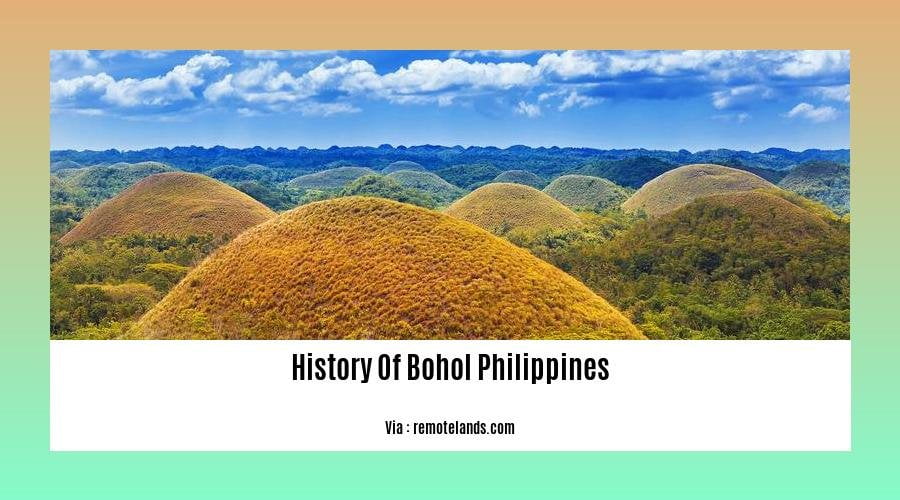
Bohol, an enchanting island in the Philippines, boasts a rich history that has helped shape its unique identity. From its ancient origins to the colonial era and beyond, Bohol has witnessed a tapestry of events that have left an indelible mark on its landscape and culture. Let’s delve into the captivating History Of Bohol Philippines Wikipedia and explore the fascinating stories that have unfolded in this remarkable province.
Bohol’s Early Settlers
- The earliest known inhabitants of Bohol were the Boholanos, who were believed to have arrived from mainland Southeast Asia around 3000 BC.
- These early settlers established thriving communities and developed their own unique culture and traditions.
Spanish Colonization
- In 1565, Miguel Lopez de Legazpi, a Spanish conquistador, arrived in Bohol and claimed the island for the Spanish Crown.
- The Spanish established a settlement in Bohol and introduced Christianity, which eventually became the dominant religion on the island.
Bohol Under Spanish Rule
- Bohol remained under Spanish rule for over 300 years, during which time the province experienced significant cultural and economic changes.
- The Spanish introduced new agricultural practices, such as the cultivation of rice and corn, and established trade links with other parts of the Philippines and the Spanish Empire.
American Occupation
- In 1898, the United States defeated Spain in the Spanish-American War and gained control of the Philippines, including Bohol.
- The Americans introduced a number of changes to Bohol, including the establishment of a public school system and the construction of new infrastructure.
World War II and the Japanese Occupation
- During World War II, Bohol was occupied by the Japanese from 1942 to 1945.
- The Japanese occupation was a difficult time for the people of Bohol, who suffered from food shortages, disease, and forced labor.
Post-War Bohol
- After World War II, Bohol became a part of the independent Republic of the Philippines.
- The province experienced a period of rapid economic growth and development, and tourism emerged as a major industry.
Key Takeaways:
- Bohol’s earliest known inhabitants were the Boholanos, who arrived from mainland Southeast Asia around 3000 BC.
- Spanish conquistador Miguel Lopez de Legazpi claimed Bohol for the Spanish Crown in 1565, introducing Christianity and establishing a settlement.
- Bohol remained under Spanish rule for over 300 years, experiencing cultural and economic changes.
- The Americans occupied Bohol from 1898 to 1942, introducing a public school system and constructing new infrastructure.
- The Japanese occupied Bohol from 1942 to 1945, causing food shortages, disease, and forced labor.
- After World War II, Bohol became a part of the independent Republic of the Philippines and experienced rapid economic growth and development.
Sources:
– Bohol – Wikipedia
– History of Bohol – Bohol Philippines Travel Guide
FAQ
Q1: What is the origin of the name “Bohol”?
A1: The name “Bohol” is derived from the local word “bo-ol,” which refers to a type of tree that was once abundant on the island.
Q2: Who were the first inhabitants of Bohol?
A2: The earliest known inhabitants of Bohol were the Pintados, a group of people who were known for their elaborate body tattoos.
Q3: When did Bohol become a separate province from Cebu?
A3: Bohol became a separate politico-military province on July 22, 1854.
Q4: What are the major historical attractions in Bohol?
A4: Some of the major historical attractions in Bohol include the Chocolate Hills, the Tarsier Conservation Sanctuary, and the National Museum of the Philippines – Bohol.
Q5: What is the significance of the Sandugo Festival?
A5: The Sandugo Festival is a celebration that commemorates the blood compact between Datu Sikatuna and Miguel Lopez de Legazpi, which is considered to be the first treaty of friendship between the Philippines and Spain.
- China II Review: Delicious Food & Speedy Service - April 17, 2025
- Understand Virginia’s Flag: History & Debate - April 17, 2025
- Explore Long Island’s Map: Unique Regions & Insights - April 17, 2025
